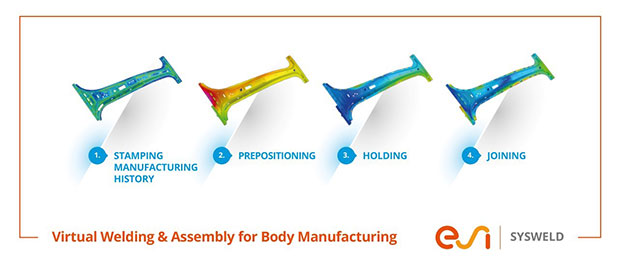
After inheriting details of the “as manufactured” components from the press shop, SYSWELD simulates the entire assembly and welding process chain in the body shop step by step. Composite image courtesy of ESI Group.
Latest News
September 27, 2017
A North Sea oil rig capsized, taking 120 lives nearly 30 years ago. Investigators concluded that fatigue cracking in a structural brace emanating from a single, 6-mm weld with a bad profile began the chain of events that led to the catastrophe. Whether in a complex machine, a car body, a boat or countless other applications, you have to have your welding and heat treatment design and analysis acts together. Today’s Editor’s Pick of the Week is intended to help you design and optimize welds and weld patterns to mitigate the odds that the one weld that led to disaster was your design.
ESI Group recently released SYSWELD 2017, the latest version of its FEA (finite element analysis) multiphysics simulation solution for assembly, welding and heat treatment. The short description is that SYSWELD is an end-to-end predictive analysis solution for manufacturing welded and assembled industrial parts.
 After inheriting details of the “as manufactured” components from the press shop, SYSWELD simulates the entire assembly and welding process chain in the body shop step by step. Composite image courtesy of ESI Group.
After inheriting details of the “as manufactured” components from the press shop, SYSWELD simulates the entire assembly and welding process chain in the body shop step by step. Composite image courtesy of ESI Group.SYSWELD handles a variety of thermal, chemical, metallurgical and mechanical phenomena. It can help you develop and optimize welding plans, maintain welding distortion tolerances and control high stresses. With it, you can simulate thermal joining, including arc, electron beam, laser, friction and spot welding. You can also simulate carburizing (carburization) and quenching heat treatments. It helps you take into account manufacturing effects, and it lets you send simulation results from one manufacturing step to the next.
Version 2017 adds new support for carbonitriding techniques. Additionally, it now supports spot welding using spacers and friction stir welding processes. It has new meshing capabilities that should save time making dedicated meshes for welds and heat treatments. There’s also new automatic control of the interpass temperature between each weld. For shipbuilders, SYSWELD 2017 debuts functionality to ensure distortion control for large welded assemblies with thick plates and multi-pass welds.
For distortion engineering in car body manufacturing, SYSWELD 2017 introduces enhancements for modeling of the full stamp-welding-assembly simulation. Basically, you can now virtually manufacture, assemble and test physically realistic components before you get into prototyping real-world hardware. Features here include the ability to control the dimensional inaccuracies of hot- and cold-joined assemblies and the ability to take into consideration the load effects of successive assembly processes as well as welding-induced heat.
Welding and heat treatment are mission-critical processes in all sorts of manufacturing industries. SYSWELD could help ensure that your processes are spot on. Hit today’s Editor’s Pick of the Week link and learn more.
Thanks, Pal. – Lockwood
Anthony J. Lockwood
Editor at Large, DE
Subscribe to our FREE magazine, FREE email newsletters or both!
Latest News
About the Author
Anthony J. Lockwood is Digital Engineering’s founding editor. He is now retired. Contact him via [email protected].
Follow DE







